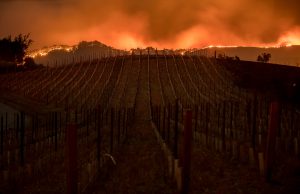Just between Fleurie and Julienas, Moulin-à-Vent, a hill with a name that translates to ‘windmill’ as a tribute to the very one from the 15th century atop it, may at times represent the pinnacle of the 10 Beaujolais crus. If you’ve sampled Beaujolais crus and have yet to uncork an esteemed bottle from Moulin- à -Vent, you simply must rectify this at once.
The wines here are concentrated with a tannic structure that may sometimes seem echelons above the rest. That’s particularly notable for the entire region of Beaujolais is rather prized. Though here, patience pays since the wines are really at their prime after aging 10 years. If you’ve heard of exemplary bottles of Beaujolais that have aged 50 years or more, it is almost always a Moulin-à-Vent although it is a rarity and it must have just the perfect producer touch and vintage.
The other crus tend to have a granite base as well, but what separates Moulin-à-Vent from them is that the soils here contain manganese. In higher concentrations, it could kill the vines, but here, there’s only enough to keep the grape yield lower. What this does is create more concentrated berries for an extreme flavor.
Coupled with the slopes of the hill and the ample sunshine, the grapes ripen to their fullest potential. It creates a majestic quality in the wines, one that becomes more intense with every sip.
When it comes to choosing the finest of them all, few hold a candle to Pierre Chermette and his Domaine de Vissoux. Years ago, he only made wine in the Beaujolais AC but ever since the 1990’s, he began taking on land in the crus. The standout is Les Trois Roches of Moulin-à-Vent. The name denotes the three unique parcels where the grapes for his wine are born. Rochegres adds what Chermette notes as “finesse” while La Rochelle brings the structure. Roche Noire adds the life to it. All of these grapes are joined together by Chermette for an astounding creation, one that is made the natural way as the original Burgundian ways once were, completely free of sulfur.
As any wine aficionado knows, drinking Beaujolais is akin to standing on top of the world. Yet from Domaine de Vissoux, the practices are sustainable, chemical-free, and steeped in traditional roots which all yield some of the most phenomenal offerings out of Moulin-à-Vent. It’s little surprise that you’ll find it gracing the wine lists of the finest restaurants in France and at the top of Les Meilleurs Vins de France, the French wine guide.
The difference with this producer is quite simple. Hand-harvesting only fully ripe Grenache grapes and reducing the yields makes for the fullest ripeness. It’s impeccable stuff, and the fact that green practices are used really speaks to today’s consumer who wants to make a sustainable and healthful choice that is abundant in spectacular flavor.







